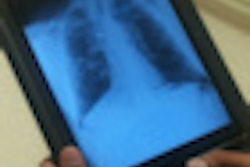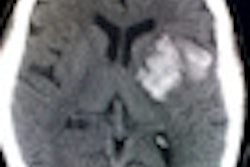Apple's iPad shows significant potential for a number of radiology applications, but primary interpretation of medical images probably isn't one of them, at least for the current generation of the tablet computer, according to researchers from the University of Maryland in Baltimore.
While its display technology is probably sufficient to handle the job, the iPad's utility for primary interpretation in radiology remains limited by visual, ergonomic, technical, and regulatory hurdles, according to Kamran Shah, MD.
"Where the potential lies in terms of existing technologies and applications [includes] [electronic medical record (EMR)] dashboards, patient interaction and consent forms, education, and as an adjunct for PACS workstations," Shah said.
Shah discussed the prospects for the iPad in radiology during a scientific session at the 2010 RSNA meeting in Chicago.
A lot to offer
At first glance, the iPad's hardware has a lot to offer. It's about one-third the weight of the average thin laptop and about three times the weight of Amazon's Kindle e-reader.
"And it's a whole lot lighter than a 40-lb PACS [display]," he said. "So it's definitely portable."
The iPad's 9.7-inch backlit display employs white LEDs in lieu of cold cathode fluorescent lamps; this provides a higher contrast ratio and increased light output compared to nonwhite LEDs, Shah said. And the LEDs are deployed in an edge-lit configuration, which facilitates a thickness of only 0.5 inches.
It also utilizes in-plane switching technology, which offers benefits such as wider viewing angles and improved color reproduction. Though it doesn't have the retina display featured on the iPhone 4, the iPad provides a resolution of 1024 x 768 pixels. That's sufficient for two frames of 512 x 512 CT or ultrasound images, Shah said.
The iPad display yields a pixel density of 132 pixels per inch, which approaches the pixel density found on 5-megapixel displays, Shah said. It also provides a resolution of 2.6 line pairs per millimeter, which meets the American College of Radiology's (ACR) display recommendation.
It has a display luminance of 300 cd/m2, which is similar to what is found on 24-inch PACS monitors.
"If you turn this up to, say, 100% max brightness and hold it in your hand, a 9.7-inch display that you're going to hold a few inches from your face is incredibly bright," he said. "This is a very bright device. Its contrast ratio is on par with what we're seeing with monitors that are being used in diagnostic applications."
Under the hood
The iPad is powered by the proprietary A4 System-on-a-Chip, which combines central processing unit (CPU), graphics processing unit (GPU), and hardware controllers. The fully autonomous GPU can render 720p video and do it in parallel with CPU tasks, Shah said.
Speed is not a high point for the iPad, however. Tests have shown that the iPad is orders of magnitude slower than a PACS workstation, Shah said.
"The iPad is anemic when compared to a PACS," he said. "This is a mobile-class processor, it's not a desktop-class processor. So it's important to recognize that."
Data connectivity is provided via 802.11n Wi-Fi, 3G capability, and Bluetooth 2.1. Memory is nonupgradeable and nonremovable, Shah said.
The iPad runs on a heavily modified version of the iPhone operating system. Multitasking was only recently added in late 2010.
"Applications will have to be rewritten to take advantage of the multitasking -- to, for example, enable DICOM viewing, speech recognition, and EMR right at the same time," he said.
As for security, the iPad offers integration with enterprise security standards and supports Microsoft Exchange ActiveSync policies. Local data are encrypted, and both local and remote data wipe is supported in case the device falls into the wrong hands, Shah said.
Primary interpretation?
There are many DICOM visualization applications being developed for the iPad, all of which are going to require server-side rendering given the iPad's mobile-class processor, Shah said.
Another hurdle for diagnostic use will be the iPad's 9.7-inch display, which is going to pose ergonomic challenges if used for any protracted period of time for primary interpretation, he said.
And U.S. Food and Drug Administration (FDA) clearance for these applications remains a difficult road, Shah said.
"No DICOM visualization applications have been FDA 510(k) [cleared]," Shah said. "There have been a couple of mobile patient data applications that have been FDA 510(k) [cleared] for the iPhone and iPad, but none for image interpretation."
The iPad may also find a niche in a number of nondiagnostic image viewing applications, such as having house staff review images and reports while on rounds, Shah said.
Electronic medical record applications are another active area for the iPad, and there are more than 20 such apps in the iTunes App Store.
"The important thing about these applications is that while they do integrate with the enterprise EMR, there's the possibility of really novel integrations of data," he said. "So that you can have customized views for clinicians or for patients, [providing] a specialized dashboard for the individual user."
Clinicians could also use iPad for showing images to patients without being tethered to a PACS workstation, he said.
In addition, the iPad could be used to transform paper-based processes such as patient consent forms and questionnaires. Resident education also represents a promising application for the iPad, allowing users, for example, to interact with images while reading actual presentations, Shah said.
The iPad could also be used as an interface device, replacing other devices that are prone to failure with a multitouch device that's easier to use and less prone to fail, he said. It could be used for controlling a PACS or even for controlling an imaging modality.
"Multitouch capabilities are built into Windows 7, so it's not a huge step to imagine that this could happen," Shah said.
The iPad could be also used as inspiration for next-generation interfaces, he said.
"The whole concept of what the iPad has done for [user interface] design can be dramatic," he said.
By Erik L. Ridley
AuntMinnie.com staff writer
January 17, 2011
Related Reading
iPad holds up well for assessing tuberculosis, November 29, 2010
iPhone can aid in triage of head injury patients, November 19, 2010
Report: iPad use surges in healthcare, November 16, 2010
Is the iPad radiology's dream device for mobile healthcare? June 24, 2010
TEPR founder sees big role for small systems in healthcare, June 24, 2010
Copyright © 2011 AuntMinnie.com



















